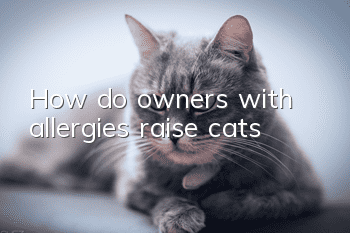Feline Immunodeficiency Virus (Feline AIDS) Symptoms and Treatment

Feline immunodeficiency virus can also be called feline AIDS, but this so-called AIDS is not transmitted through sexual intercourse, but is infected through the saliva of cats when they eat together and the wounds caused when cats fight with each other.
Feline immunodeficiency virus disease was discovered in 1987. It belongs to the genus Lentivirus in the family Retroviridae. Cats infected will suffer from Feline Acquired Immune Deficiency Syndrome. Clinically, the disease is characterized by chronicity, variability, and immunosuppression. and a decrease in the number of helper T lymphocytes. Infection between cats is mainly spread through saliva and bites. Receiving blood transfusions from sick cats is also one of the causes of infection, and vertical transmission is rare.
What are the symptoms of Feline Immunodeficiency Virus
Although feline immunodeficiency virus disease is also called feline AIDS, it is very different from the AIDS we understand, and the mortality rate of the disease is not very high. Some sick cats can still live to Normal life span.
Cats infected with FIV generally display a variety of non-specific clinical symptoms. Fever, otitis, lymphadenopathy, oral mucositis, gingivitis, uveitis, chronic renal insufficiency, and long-term diarrhea. Upper respiratory tract infections are the most common. Infected cats are susceptible to opportunistic infections. Owners often notice clinical signs unrelated to the disease, including decreased activity, lethargy, and weight loss in cats.
Prevention and treatment of feline AIDS
Many cats remain asymptomatic for weeks to years after infection, which makes diagnosis more complicated, and laboratory results are not specific to feline FIV. And it is not very helpful in diagnosing FIV. Mild, nonregenerative anemia, neutropenia, and lymphopenia occur in half of infected cats.
What are the methods to treat feline immunodeficiency virus
Generally, feral cats are a group with a high incidence of feline immunodeficiency virus, so when owners take their cats out, it is best to avoid contact with stray cats to prevent them from getting into disputes and getting injured and thus infected with the disease. If the cat is found If you already have corresponding symptoms, you should treat them as soon as possible.
Cats with anemia, neutropenia, oral mucositis, glossitis, lymphoma, and chronic upper respiratory tract infections should be evaluated for FIV infection. There is currently no FIV-specific antiviral therapy. However, the use of nucleoside drugs, such as AZT and RMEA, can reduce viremia and increase the number of CD4+ lymphocytes. However, the use of the above two types of drugs will cause obvious side effects, such as anemia.
Human recombinant n-interferon is widely used to treat immunodeficient cats after the treatment of retroviral infections. The treatment is not expensive and can improve the quality of life. FIV-positive cats are susceptible to many secondary and opportunistic infections. Maintenance therapy has been shown to help prolong treatmentEffective cats live from months to years.
- Four major misunderstandings that cats should pay attention to when keeping warm in winter!
- Early symptoms of chronic stomatitis in cats
- Characteristics of cats in heat
- Can Boli Fishing Cat be eaten?
- Scottish fold cat advantages and disadvantages
- 2 month old kitten has diarrhea but is in good spirits
- Will it be difficult to give birth to a 7-month-old cat during pregnancy?
- Give your cat a name that’s easy to call and remember.
- Four signs your cat likes you
- Why do cats have barbs?



